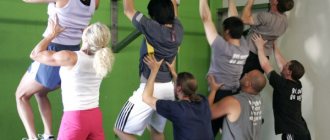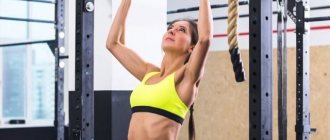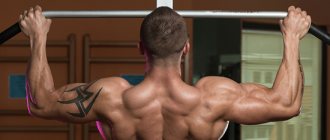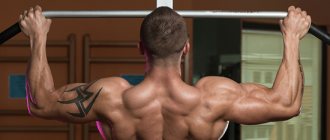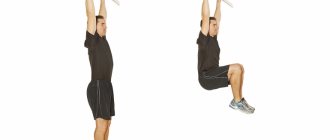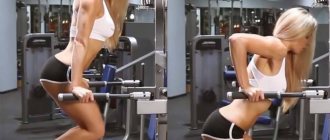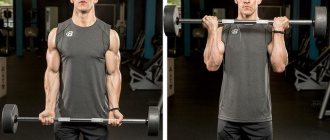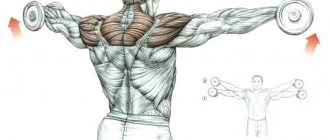How to do pull-ups correctly - basic rules
There are two types of pull-up techniques.
The first is for passing standards, and the second is performing an exercise with the goal of pumping up certain muscle groups. This type of technique is actively used in bodybuilding.
Pull-up technique for passing the standard
So, let’s look at the rules for doing pull-ups on the horizontal bar to pass the standard:
- Starting position – hanging on the crossbar. Hands slightly wider than shoulders, straight grip, palms facing away (reverse grip is not allowed).
- Pull up until your chin touches the bar.
- Smoothly lower down until full straightening in the elbow and shoulder joints.
- During the exercise, keep your legs together, knees bent or straight.
- Help from the legs and torso is prohibited (without inertia or swing).
Such strict rules when passing the standard on the horizontal bar are designed to provide equal conditions for everyone.
Pull-up technique in bodybuilding
Another thing is the pull-up technique in the gym.
The main goal here is to work out the muscles. Therefore, the rules for performing the exercise are radically different.
For example, consider the technique of wide-grip pull-ups to the chest:
- In the starting position, the arms are slightly bent to create additional tension in the latissimus muscles.
- At the start, the pelvis moves slightly forward, and the shoulders lean back. The chest is brought forward and upward.
- The movement begins with bringing the shoulder blades together, that is, the emphasis is placed on the back muscles.
- Bend your elbows and reach the top point (before your chest touches the bar), smoothly return to the starting position without fully extending your arms.
Types of grips for pull-ups
There are many variations of pull-ups on the horizontal bar. Depending on the width and grip, the load shifts to different muscle bundles.
Main types of grips:
- Reverse grip (underhand grip, palms facing you)
The easiest and most affordable version of pull-ups. Here the biceps are included in the work as much as possible.
- Straight grip (overhead, palms facing away from you)
Here the load is evenly distributed across the working muscles - the latissimus, biceps, forearms.
- Wide straight grip to the chest
The emphasis of the load shifts to the lats.
- Wide straight head grip
The lats also work well. But if there is insufficient mobility of the thoracic region, this grip can overload the shoulder joints.
- Parallel grip to the chest (palms facing each other)
For such pull-ups, a special handle is used. The latissimus dorsi muscles are actively involved in the work, with an emphasis on the middle and lower sectors.
Types of pull-ups
12 variations, ranging from classic to super heavy on a towel, to progress with this popular exercise. When you learn to do 6-8 repetitions, try to increase the difficulty - approximately you need to add one pull-up per week.
Negative pull-ups
Stand on the bench in the top position of the exercise (chin above the bar). Go down as slowly as possible. What it's used for: It's quite difficult to do a full set, but this exercise will completely fatigue the muscles and help develop the strength necessary to perform the movement. Difficulty: 1/10.
Pull-ups with swinging (kipping)
It is performed exactly the same as the classic version, except that you swing your legs to create momentum (inertia) to move upward. What you need it for: strengthens the back muscles at the initial stage of training. Difficulty: 2/10.
Reverse close grip pull-ups
Grasp the horizontal bar as narrowly as possible, with your palms facing you. What is it for? This option maximizes the work of the biceps brachii muscle (biceps) and reduces the load on the back. This makes the exercise easier. Difficulty: 3/10.
Classic
Hang on the horizontal bar with an overhand grip, hands slightly wider than shoulder-width apart. The elbows are fully straightened and the body is straight. Pull your weight up and contract your latissimus dorsi until your chin is over the bar. Then lower yourself down without rocking. This is a traditional technique that will give more load than the first three options. Difficulty: 4/10.
Tarzan Pull Up
Grab with an overhand grip, your hands almost touching each other. Pull yourself up. At the top point, lean to the right and slightly up. Get down. Repeat the same on the left side.
This requires better coordination at the top and also strengthens the torso (core) musculature, which prevents the body from swaying.
Difficulty: 5/10.
Pull-up on both sides
Grab it with a different grip, your hands almost touching each other. In this exercise you need to lift yourself higher to touch the horizontal bar with your shoulder. First you need to train your body to pull yourself up as high as possible, ideally try to touch your chest. As you become stronger in this exercise, you will pull yourself even higher, while tilting your head alternately in each direction. This type requires a more explosive "thrust". More demands are placed on the core musculature to stabilize the body during this quick exercise. Difficulty: 5.5/10.
Pull-ups with knee rotations
At the top of the exercise, lift your knees toward your chest and twist to the left, then to the right. Return to the starting position. Goal: The muscles of the entire torso (core) are worked during knee rotations, as well as the rectus and oblique abdominal muscles. Increased load on the muscles of the back and biceps. Difficulty: 6/10.
Pull-up with leg raise
At the top of the movement, raise your legs in front of you until they are parallel to the floor.
Then return to the starting position. What does the exercise do? Loads the abdominal muscles and slows down the pull-up. Therefore, the back muscles work harder. Difficulty: 7/10.
Walking pull-ups
Standard grip, shoulder-width apart. Move your legs back and forth, imitating walking as you rise and move down. To perform the “walk” slowly, you need to have very developed, strong upper body muscles. Therefore, first you need to do a lot of pull-ups with turning your knees and get stronger in this type of movement. Purpose: This is a very heavy type of load. The slower you do it, the more difficult it is. It also engages the muscles of the torso and abdominal muscles. Difficulty: 7.5/10.
Weighted
Attach a barbell plate to your belt or grab a dumbbell between your legs before starting the exercise.
Goal: when you are already strong enough and can do a lot of pull-ups on the horizontal bar in the classic version, adding weight additionally “shocks” and makes the muscle fibers grow stronger and larger.
Difficulty: 8/10.
Around the world
Pull yourself up on the horizontal bar.
Then move your body first to the left and then to the right before returning to the starting position. What the exercise does: it requires a lot of strength in the entire upper body to move the torso sideways under control (without swaying).
Difficulty: 9/10.
Common mistakes in technology
Correctly doing pull-ups on the horizontal bar is quite simple. However, there are often technical errors here.
The most common mistakes when doing pull-ups:
- Jerky, inertial upward movements
The movement is performed not by muscle power, but by speed and inertia. Muscle work with this technique is minimal.
- Quick descent.
For muscle hypertrophy (growth), not only the ascent phase is important, but also the descent phase. By “falling” down, you deprive the muscles of a significant part of the load.
- Incomplete range of motion
By limiting the amplitude of the exercise, the muscles are pumped only in a certain area. Long-term use of this technique contributes to muscle shortening, which is unacceptable from an aesthetic point of view.
- Improper breathing
Leads to an increase in pressure and impairs the supply of oxygen to tissues.
Additional recommendations
Many people are concerned about the question of when to expect the first results. It all depends on the child’s level of preparedness. Some will be able to pull themselves up in a week of training. But if a teenager has never exercised before, it will be more difficult to achieve what he wants. And even with regular training, the first ten pull-ups per set can take up to 3 months. If a girl is studying, progress will also be a little slower.
An important factor is excess weight. Before a 12-year-old child learns to do pull-ups from scratch, it is important to think about nutrition. You should control your consumption of simple carbohydrates: flour and sugar-containing foods. You need to replace sweets with cereals: buckwheat, oatmeal and durum wheat pasta. Don't forget about fiber and adequate protein intake. If you follow a healthy diet, progress will not take long.
Recommendations from trainers on how to properly teach a child to do pull-ups on a horizontal bar from scratch will help you easily master the technique. Exercises contribute not only to the physical, but also to the mental development of a teenager, because, as you know, sport develops discipline. This will have a beneficial effect on all aspects of the child’s life.

A lot of time may pass before your child’s first tangible results; the main thing is to train regularly and not rush things.
Basics of proper breathing when doing pull-ups
When doing pull-ups on the horizontal bar, proper breathing plays an important role.
Basics of proper breathing:
- Take a short breath at the start
- The upward movement begins while holding your breath
- Having reached the middle of the amplitude, we exhale
- The end of the exhalation should coincide with the final point of the movement
- We lower ourselves smoothly and under control to the starting position, taking a smooth breath as we move.
You absolutely cannot hold your breath completely! This can cause increased blood pressure and poor health.
Pull-up technique on the horizontal bar
Use the entire range
For what:
Using a full range of motion forces more muscle fibers to work and increases the load.
How:
Hang from the bar with both arms so that they are fully extended. These are the start and end positions. Perform the full range of exercises slowly and calmly to reduce tension.
Start from the beginning
For what:
A stable body position will force the large and small stabilizing muscles to work to make weight management easier.
How:
Point your chest up and tighten your abs and buttocks. Begin the movement by drawing your shoulders in and then moving your elbows down to pull yourself up.
Tighten up at the top
For what:
Once your chin is higher than your arms, squeezing your working muscles will require even more muscle fibers to work for greater strength and improved performance.
How:
Pause for one second at the top to squeeze the muscles, then lower back down to the starting position.
Exercises on the bar to make pull-ups easier
Tips from trainer Andy Watson:
- Vary your grip: “Alternate between a wide, narrow and regular grip to recruit more muscle fibers and correct any weaknesses,” says Watson.
- Break it down: "Break the pull-up into three phases," advises Watson. “Pull your chest toward the bar, hold for three seconds, lower down halfway, pause, then lower back to the starting position and repeat.”
- Hold on tight: “If your grip is strong, you are strong. Get used to hanging on the bar with extra weight until you fall. Then lifting your own weight when doing a pull-up will seem easy to you.”

